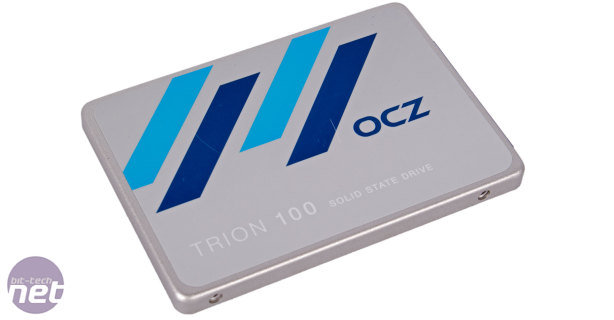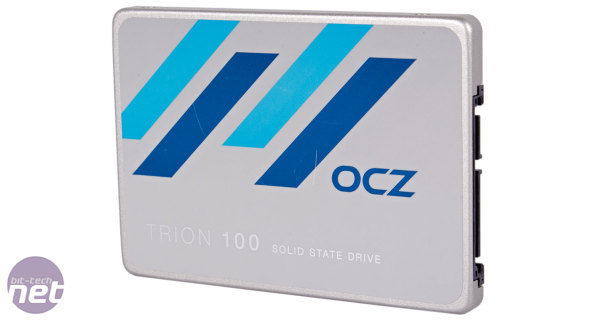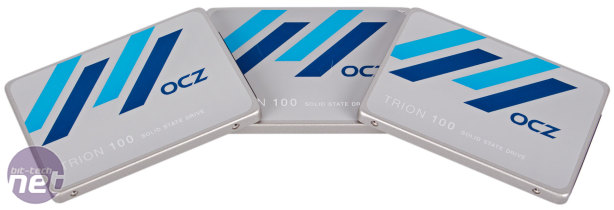OCZ Trion 100 Review (240GB, 480GB & 960GB)
September 3, 2015 | 09:05
Companies: #ocz #ocz-storage-solutions #toshiba

Performance Analysis
The basic performance snapshot given by CrystalDiskMark paints a good picture for the Trion 100, which near enough meets its stated performance figures. The quasi-SLC cache helps to keep sequential write speeds above 500MB/sec, as the 1GB of data comfortably fits into it at all capacities. The lower number of NAND dies in the 240GB model means its write speed drops in the QD32 test, but this is an irrelevant workload for the target market and more just to show the drive's limitations.Steady state performance is unsurprisingly low; TLC NAND is simply slower to write to and as a value drive the Trion 100 isn't designed for sustained workloads. The standard deviation results also show us that it's performance consistency is low as well.
Sequential read performance is a strong point, with the Trion 100 beating OCZ's own Arc 100 240GB and the SK Hynix SC300 256GB at a queue depth of 1. At QD4, it still leads but only slightly. Performance here is the same across all three capacities. Sequential write performance is a different story, with the Trion 100 doing significantly worse than the other two drives. It starts off fast as the first writes hit the pseudo-SLC cache but once that fills the performance drops to around 115MB/sec as writes are subsequently sent directly to the TLC NAND. What's worse is that performance doesn't scale upwards with capacity; 115MB/sec or so is the rough baseline for all three drives. The only reason the 960GB is the best of the three in the charts is that we take the average speed from the whole 1 minute run, which includes the time spent writing to the faster cache. The 960GB's cache is the largest, so it can maintain a high speed for longer before falling to baseline, which sends up the average.
Random read performance is also low compared to the other drives on test. Performance does scale up as you increase the queue depth, but again not as well as we see elsewhere. With random writes, the performance difference is even bigger, with the Trion 100 drives doing significantly worse and also failing to improve performance when moving from QD1 to QD4, unlike the other SSDs which show gains of around 70 percent.
Mixed workloads with sequential data are nothing for the Trion 100 to shout about. The drives don't do too badly in the read-heavy run, but as you increase the write workload they start to crumble and the other drives pull further and further ahead. It's a similar story with random data, but this time with an even bigger difference in performance between the Trion 100 and competing SSDs.
The PCMark 8 traces put the trio of drives here at the bottom of the charts each time, although the differences are far smaller than what we've seen thus far – a Trion 100 is unlikely to be noticeably slower in the day to day applications and games of a home user.
Conclusion
The Trion 100 SSDs fall over in most of our Iometer testing, and compared to the other drives we tested they just don't really handle any form of sustained or intensive workloads well. The TLC NAND is likely more to blame than the controller or firmware in most instances, though we did hope to see better scaling with capacity on sequential writes, for example. However, as we've said, mainstream user workloads for SSDs tend to come in bursts, with frequent idle periods and at very low queue depths. In such instances, as the PCMark 8 traces show, the Trion 100 is still slower but by a much smaller margin; one that would likely be hard to notice unless you constantly write large amounts of data at once.Ultimately, the Trion 100 needs to be extremely competitive on price to succeed, as in terms of performance and features it's lacking. However, its pricing is too high for us to recommend it. Even OCZ's own Arc 100, which ranks above the Trion 100 in the company's own stack, is similarly priced, and the SK Hynix SC300 is better all round too for very similar cash. The endurance, warranty and software are highlights but not enough to save the Trion 100, which must fall in price by a fairly significant amount in order to be worth a purchase.
-
Performance28 / 50
-
Features9 / 15
-
Value30 / 35


MSI MPG Velox 100R Chassis Review
October 14 2021 | 15:04











Want to comment? Please log in.